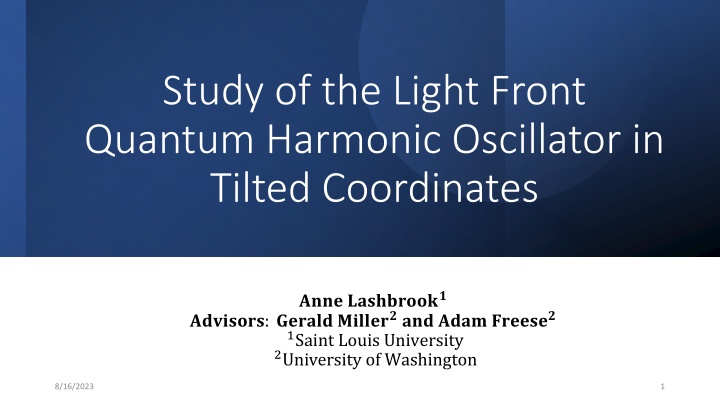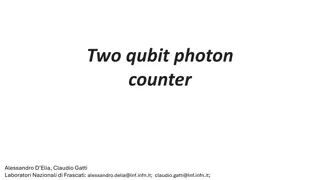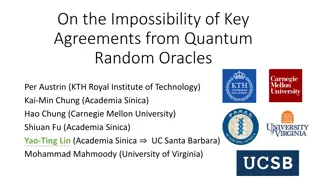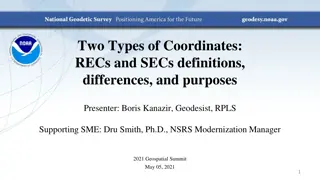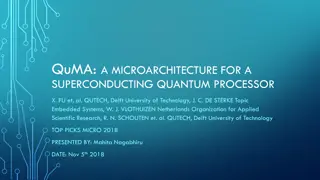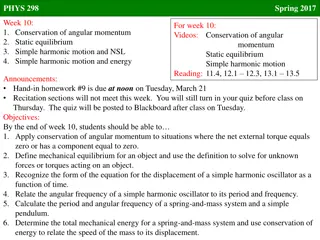Study of the Light Front Quantum Harmonic Oscillator in Tilted Coordinates
This study delves into the Light Front Quantum Harmonic Oscillator in Tilted Coordinates, exploring the motivation, wavefunction, and Hamiltonian matrix approximation. It discusses the challenges in obtaining analytic or perturbative solutions in nuclear physics and showcases the Light Front Formalism introduced by Paul Dirac. The investigation involves the Quantum Harmonic Oscillator and the Time-Independent Schrödinger Equation.
Download Presentation

Please find below an Image/Link to download the presentation.
The content on the website is provided AS IS for your information and personal use only. It may not be sold, licensed, or shared on other websites without obtaining consent from the author.If you encounter any issues during the download, it is possible that the publisher has removed the file from their server.
You are allowed to download the files provided on this website for personal or commercial use, subject to the condition that they are used lawfully. All files are the property of their respective owners.
The content on the website is provided AS IS for your information and personal use only. It may not be sold, licensed, or shared on other websites without obtaining consent from the author.
E N D
Presentation Transcript
Study of the Light Front Quantum Harmonic Oscillator in Tilted Coordinates ???? ?????????? ????????: ?????? ?????????? ???? ??????? 1Saint Louis University 2University of Washington 8/16/2023 1
Overview Motivation Finding the Wavefunction Approximating Hamiltonian Matrix 8/16/2023 2
Motivation The field of nuclear physics and the light front formalism 8/16/2023 3
Nuclear Physics Systems of hadrons and nuclei from quantum chromodynamics (QCD) Problem : analytic or perturbative solutions at low- energy are difficult or impossible to obtain. Lattice QCD Computationally intensive https://energywavetheory.com/wp-content/uploads/2016/08/quarks-and-neutron-300x300.png 8/16/2023 4
The Light Front Formalism Light Front Formalism: Introduced by Paul Dirac in 1949 Alternative synchronization convention New conventions may be more likely to solve certain problems. Tilted Coordinates: Tilted light front coordinates: ? = ?0 ?+= ? + ? ?1 ? ?2 ? ?3 ? Light travels instantaneously in the z direction. Image Credit: Adam Freese 8/16/2023 5
The Light Front Formalism (cont.) Standard Coordinates: ?2+ ?2 ? = Klein-Gordon equation gives energy-momentum relation: ? =?2+ ?2 2 ?? Hamiltonian Operator: ? =?2+ ?2 + ? 2 ?? 8/16/2023 6
This Summer: The Quantum Harmonic Oscillator Quantum Harmonic Oscillator Review ? =1 2??2 ?2 Plan of Attack: If analytic solution: Find wavefunction and energy eigenvalues given Hamiltonian. If approximation necessary: Find approximate wavefunction. Calculate Hamiltonian matrix and approximate energy eigenvalues. 8/16/2023 7
Finding the Wavefunction Analytic Attempt and Approximation 8/16/2023 8
Time-Independent Schrdinger Equation ?? = ?? where ? =?2+ ?2 + ? 2 ?? ?? =?2+ ?2 ? +1 2??2 ?2? 2 ?? 8/16/2023 9
Analytical Solution? Separation of Variables: ?(?,?,?) = ? ? ? ? ?(?) ? =?2+ ?2 2?? RHS: mixes orthogonal and z-component of momentum operator 5 2 3 2?2 4?? 3 2+ 2??? 1 2+? 1 2? 5? 1 2?? 1 2?? 1 2 + ??? ? + ??? = 0 1 2 ?? Faced with difficult equation for the pz-component of the wavefunction, so let s try an approximation method 8/16/2023 10
Wavefunction Approximation Breaking Hamiltonian into radial and z components: ? = ?0+ ? 2+ ?2+ ??2 2?? ? =??2?2 2 +??2? ?0=? 2 2 Can treat H0 as modified planar harmonic oscillator. Find wavefunction for H0. Goal: calculate energy eigenvalues. 8/16/2023 11
Aside: Planar Quantum Harmonic Oscillator Solution should resemble that of the 2D planar QHO in cylindrical coordinates: Laguerre Polynomials: ?? ?? satisfies: ?? + ? + 1 ? ? + ?? = 0 8/16/2023 12
Wavefunction Approximation (cont.) Radial solution: ????2?2 2 ? ? = ? ? ????2?2 ?? Wavefunction: 2 ????2????? ? ?,? = ?? ??2 2? 8/16/2023 13
Approximating Hamiltonian Matrix Obtaining the energy eigenvalues 8/16/2023 14
Construction H0 + V ?+1 2( ????2+?2+?? 2?? 2 ??,?= Calculating V: ? ? ? ? 1 2??2?2??,????? ???,? 2L 0 ? 8/16/2023 15
Hamiltonian Matrix H0 V 8/16/2023 16
4x4: L-Dependence Approximation to the actual wavefunction. Eigenvalue approximations break down for large or small values L. Increasing Hamiltonian matrix size leads to better approximations. 9x9: 8/16/2023 17
Hamiltonian Matrix 1 ?? ? = 1.7?? 1,? = 2.5?? 1,? = 7 4x4: 9x9: Interested in seeing how these values develop for increasing matrix size. 8/16/2023 18
Compute larger Hamiltonian matrices to track trend of L-dependence and eigenvalues. Conclusion and Next Steps Apply tilted coordinates to other potentials and boundary conditions. 8/16/2023 19
Acknowledgements Thank you to Dr. Gerald Miller and Dr. Adam Freese for taking me on this summer! Thank you to the University of Washington Physics Department and the Institute for Nuclear Theory for hosting this REU. Thank you to the National Science Foundation for sponsoring this REU. 8/16/2023 20
References [1] Freese, A., & Miller, G. A. (2023). Light front synchronization and rest frame densities of the proton: Electromagnetic densities. Phys. Rev. D, 107(7), 074036. https://doi.org/10.1103/PhysRevD.107.074036 8/16/2023 21
